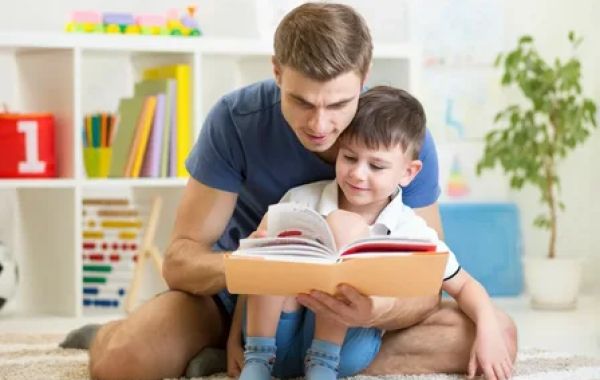At Early Literacy Learning, we think that every baby comes into the world ready to learn. From the initial coo to that memorable first word, your baby's brain is establishing the groundwork for reading and communicating later on. And do you know what can help most along the way? Books. Yes, plain storybooks.
You may be thinking, "My baby isn't talking yet—why read to them?" The reason is simple and mighty: reading to babies stimulates brain growth. The sooner you begin, the greater the advantages you provide your child for a lifetime. Reading is more than alphabet and sound. It's connection, rhythm, listening, and love. Let's discover how books to read to babies are the magic key to unlocking a world of words.
Why Books to Read to Babies Matter
Even though your baby can't talk yet, their brain is secretly listening, observing, and picking up on things every second. In fact, a baby's brain develops more in the first three years than ever again in life. That's why reading out loud is such an amazing tool. When you provide books to read to babies, you're doing a whole lot more than simply keeping them amused—you're laying the groundwork for language and learning.
As you read aloud, your baby is exposed to new vocabulary and gets used to the sound and cadence of your voice. They also learn about emotions from the tone of your voice, enabling them to recognize and respond to emotions. The images and shapes in books assist your baby in beginning to create memory and link concepts. In doing so, your baby's brain—itsy-bitsy construction supervisor—is establishing foundations for language, listening, and ultimately, reading independently.
When to Begin Reading to Your Baby
You can start reading from the moment your baby is born. Actually, there are some parents who read to their babies in utero while pregnant, finding that the relaxing sound of the parent's voice brings about pre-birth bonding. Your baby will not yet make sense of words. The sound of your voice, the soothing rhythm of a tale, and the affectionate act of cuddling up with a book all contribute to the creation of a strong emotional and mental foundation that is conducive to healthy brain development.
Babies learn best from repetition and routine, so don't be hesitant to read the same books over and over. That's how they come to recognize words, patterns, and rhythms. That's how they remember. And most importantly, that's how they learn and grow.
What Kind of Books Are Best for Babies?
When selecting books to read to children, it is critical to select those that correspond with their developmental level and increasing curiosity. Be on the lookout for the following characteristics that make reading enjoyable, interesting, and rewarding:
Board Books
These are thick, chunky books with cardboard pages that can be endured even by rough handling. They can be touched, chewed, banged, and thrown without the pages getting torn, hence ideal for exploration at an early age. Board books are great for little hands and inquiring mouths discovering the world.
Books with Simple Pictures
Infants are naturally drawn to bright colors, high-contrast images, and clear, bold illustrations. Books that have simple photographs of animals, smiling faces, or common everyday objects are particularly useful for assisting infants in starting to recognize and label what they see in their everyday world.
Repetitive and Rhyming Books
Babies thrive on repetition and rhythm. Books with predictable patterns and catchy rhymes—like Goodnight Moon, Brown Bear, Brown Bear, What Do You See? or Where’s Spot? —are not only fun to read but also help babies develop memory, language rhythm, and early word recognition. These stories become comforting favorites that babies love to hear again and again.
Touch-and-Feel Books
Books of various textures stimulate infants to touch and play while increasing usage of the remaining senses while being read to. Fluffy puppies, wrinkled dinosaurs, tender blankets, or smooth surfaces make infants use sensory experience for associations with words as learning is heightened by fun involvement.
Books containing real photos
Books that contain actual photographs of babies, animals, family routines, or daily life scenes assist infants in connecting the pictures to the world they perceive. Such books are excellent aids in assisting babies in comprehending their environment and identifying faces, feelings, and familiar environments.
Picking the correct kind of books is a easy and effective means to facilitate reading to baby and brain development right from the start. A colorful board book or touch-and-feel escapade counts in a direct way towards reading to baby and brain development and lays the ground for solid communication and cognitive advancement.
Reading Tips for Parents
Reading with babies shouldn't have to be a calm, "be still and listen" experience. In reality, it's actually fine if your baby squirms, crawls on the floor, or attempts to turn pages rapidly. It's most important to make reading a loving, enjoyable, and regular part of your daily lifestyle. Below are some easy, effective tips on how to keep reading time pleasurable for yourself and your wee one:
Read daily
Even 5–10 minutes a day can make a dramatic change in your baby's language skills and book love in the long run.
Choose a quiet time
Reading best takes place when your baby is alert and relaxed. Bedtime, naptime, or after feeding are perfect times to unwind with a book.
Express yourself
Get silly! Use goofy animal voices for their characters, fluctuate between different pitches when exciting or relaxed is needed, and whisper while setting up nighttime so it becomes peaceful.
Name and point
Point at the images and state what you can see. Read aloud in simple words and repeating and gradually, with longer sentences such as, "Hello! Here's a cat. Meow!" This familiarizes your child to linking objects to sounds and names.
Do what your baby wants.
If your baby desires to skip pages, go backward, or even bite the edge of the book, let them! These things are all a part of their discovery and learning process.
Re-read popular books
Babies thrive on repetition. Hearing the same book over and over again aids them in being able to identify words, know what is coming next, and feel secure because of the predictable rhythm.
Make it bonding time
Cuddle close while you read. Let your baby listen to the beat of your heart and feel the warmth of your voice and your hand. These are times of building emotional connection and establishing positive book-reading associations.
Reading with your baby is not about doing it perfectly—it's about being together, smiling, and nurturing a lifelong love of books.
Growing With Books
As your baby matures, so should their bookshelf. Begin with basic board books that are full of bright images and textures. As they mature, gradually add longer books with more words, concepts, and feelings.
You don't have to read through each book in one sitting. Short attention spans are to be expected—what's most important is keeping reading fun and regular. Whether they're tracing over pictures, turning pages, or simply hearing your voice, they're learning all along the way. These special moments do a great deal to help support baby brain development in the early years.
Remember, reading is not a test—it's a gift. Each book you read aloud builds your child's imagination, vocabulary, and passion for learning.
What Makes Reading with Early Literacy Learning Unique
At Early Literacy Learning, we recognize that parents are the first and finest educators. That's why we're so excited to share with you the best books to read to infants, create good reading habits, and learn about how your baby's brain acquires knowledge.
We're here to make reading at an early age fun, easy, and meaningful—because when you read to your child, you're doing more than reading a book. You're creating a lifelong learner and a confident reader.
Conclusion
In conclusion, you don't have to be a flawless reader. You don't need expensive books or a magical voice. All you need is time, love, and a book. Your baby doesn't notice if you omit words or get a little off track. Most important, what they'll always remember is that you were there, reading your time, reading your voice, and reading your heart to them. With each minute spent reading together, you create a bond that lasts forever.
So today, read a book. Sit down with your baby, smile, and let your voice animate the story. Enter the world of words together, making memories and building the foundations for a lifetime of learning. When selecting books to read to babies, don't forget that it's the relationship you develop with your baby that is most important.
We at Early Literacy Learning will be there for you each step of the way, guiding you in your path to developing your baby's passion for reading and learning.







